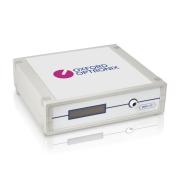Oxygenation - Transplantation and the OxyLite
Oxygen is crucial for the viability and function of transplanted organs, as it is essential for cellular respiration and metabolism, providing the energy needed for cell survival. Insufficient oxygen can lead to necrosis or apoptosis, resulting in organ failure, making it vital to maintain adequate oxygen levels throughout the transplantation process. Researchers are focused on understanding oxygen dynamics during organ removal, preservation, and transplantation to mitigate ischemia, hypoxia, and reperfusion injuries that can cause cellular damage.
An understanding of tissue oxygen is indispensable for assessing organ health during various transplantation phases, helping to predict organ response, assess viability, and optimize preservation conditions. This data will also contribute to the development of new therapies and interventions, ultimately improving the survival and function of transplanted organs post-transplantation.
OxyLite™ in transplantation research
The OxyLite™ provides real-time, direct measurements of tissue pO2 in organs and tissues. As such, this system and its minimally invasive sensors have been invaluable for researchers studying oxygen dynamics and vitality in organ transplantation studies.
By providing a continuous, accurate, and reliable oxygen readout, the OxyLite™ can help in understanding the complex interplay of factors that determine the success of organ transplantation during the pivotal preservation and transplantation steps. The system has been used in both research and industry settings to evaluate a range of transplantation techniques, modes of preservation and to assess novel transplantation devices.
Below we touch on several key transplantation papers citing the OxyLite™.
Select publications
Mesnard B. et al. 2024 (Transplantation)
Pancreas preservation: hypothermic oxygenated perfusion to improve graft reperfusion
In this article the authors explore the impact of oxygenation on the hypothermic preservation of the pancreas for transplantation.

While static cold storage is the current standard, the team demonstrates the efficacy of machine perfusion in hypothermic conditions in providing oxygen to the pancreas during preservation and conditioning the pancreatic microvasculature for reperfusion during transplantation. Furthermore, the addition of the M101 oxygen carrier as a preservation additive did seem to provide a protective effect from ischemia.
For those interested, supplementary figures S1 and S2 show the OxyLite™ sensor fixed and secured into the pancreas.
Panayotova GG. et al. 2020 (The American Journal of Surgery)
Novel oxygenation technique for hypothermic machine perfusion of liver grafts: validation in porcine donation after cardiac death (DCD) liver model
In this publication the authors wanted to improve hypothermic oxygenated machine perfusion (provided by LifePort® Liver Transporter) in liver by transplants using a novel oxygen “pre-charge” technique of pumping preoxygenated solution into the organ.

Utilizing the OxyLite™, the researchers found that “pre-charge” did sustain tissue pO2 over time. This portable machine preservation technique may improve access to liver transplants and decrease ischemic damage sustained during organ transport.
Eriksen JK. et al. 2020 (Anesthesia & Analgesia)
Goal-directed fluid therapy does not improve early glomerular filtration rate in a porcine renal transplantation model
As fluid management during renal transplantation is important for optimal organ perfusion, the authors here wanted to understand if goal-directed fluid therapy (IGDT) would improve kidney function post renal transplantation.

All metrics, including the outer medulla oxygenation provided by the OxyLite™, showed that IGDT did not improve early renal function.
Conclusions
There is good reason our OxyLite™ platform has seen extensive use in vivo within transplant studies. The system provides powerful real-time oxygen data that relays important physiological parameters to the scientist about the vitality of organs. The system continues to be used and trusted by a worldwide user-base in research institutes, universities, hospitals, pharma, CRO’s, and within military research circles.



